Condo HOA: What Every New Homeowner Must Know
Condo HOA: What Every New Homeowner Must Know
Blog Article
Exactly How Condo HOA Controls Shared Areas and Boosts Neighborhood Consistency
The governance of common areas within a condo association plays an essential duty in promoting neighborhood cohesion and maintaining residential or commercial property values. Through the facility of comprehensive standards, the Condo HOA not only regulates the use of common facilities yet additionally promotes a society of respect and responsibility amongst homeowners.
Duty of the HOA
The property owners association (HOA) offers as the controling body for condo neighborhoods, playing a crucial function in keeping the residential or commercial property and advertising a cohesive living atmosphere. It is liable for enacting and imposing community guidelines and policies, which are designed to protect the visual value and capability of the common room. This governance makes sure that all locals follow a standardized collection of expectations, promoting a sense of unity among varied homeowners.
Furthermore, the HOA takes care of the monetary elements of the neighborhood, including budgeting, gathering fees, and preserving common locations. This economic oversight is essential in ensuring that needed maintenance and renovations are performed without delay, improving residential or commercial property values in time. The HOA also serves as an intermediary between homeowners and external entities, such as city government and service companies, resolving common concerns effectively.
In Addition, the HOA usually organizes area events and programs, urging neighborly interactions and building partnerships amongst locals. By promoting open interaction and addressing grievances, the HOA adds to a harmonious living setting. Thus, its complex role is necessary in ensuring the smooth procedure and total contentment within condominium neighborhoods.
Rules for Shared Spaces
Reliable governance in condo areas necessitates clear policies for shared areas, which are essential for maintaining order and promoting a sense of area among residents. These regulations act as guidelines that make sure every person can appreciate common locations, such as pools, yards, and recreational facilities, without problem.

Moreover, cleanliness and upkeep standards are vital, usually specifying that citizens should tidy up after themselves and report any kind of problems to the house owners' association. By plainly communicating these assumptions, the HOA can motivate and reduce misconceptions regard amongst homeowners.
Inevitably, distinct rules for shared rooms add to the total lifestyle in a condo neighborhood, enabling locals to coexist quietly while appreciating the amenities that boost their living experience. condo hoa.
Value of Neighborhood Guidelines
Area standards play a considerable role in promoting a respectful and natural atmosphere within condominium organizations. These standards develop clear expectations for residents, advertising a sense of accountability and shared duty. By marking appropriate habits and methods, neighborhood guidelines help avoid misunderstandings and disputes amongst homeowners.
In addition, these standards act as a framework for preserving the aesthetic and practical stability of shared rooms. They ensure that all locals abide by requirements regarding building maintenance, noise levels, and usage of communal facilities. This uniformity not just enhances the visual allure of the community but additionally adds to total residential property worths, benefiting all house owners.

Problem Resolution Methods
Navigating conflicts within a condo association requires an organized technique to guarantee effective and fair resolution. Reliable dispute resolution strategies usually start with open communication, urging citizens to voice concerns in a considerate way. Developing an assigned channel for complaints, such as a recommendation box or an on-line forum, can facilitate this process.
Mediation is one more essential strategy, where a neutral 3rd party helps contesting citizens get to an equally agreeable solution. This technique promotes collaboration and understanding, lessening hostility - condo hoa. The HOA board should likewise develop clear procedures for addressing problems, making certain all celebrations recognize the steps entailed
Regular conflict resolution training for board members can improve their capability to manage disagreements effectively. Utilizing a well-defined structure, such as the "Interest-Based Relational Technique," assists concentrate discussions on interests instead of positions, promoting a solutions-oriented state of mind.
Benefits of Community Consistency
Cultivating area consistency within additional reading a condo association brings numerous advantages that boost the total living experience for locals. A harmonious neighborhood encourages cooperation and collaboration among neighbors, bring about a more jovial environment. When locals really feel reputable and linked, they are more probable to take part in common tasks and get involved in decision-making procedures, causing a stronger sense of belonging.
Moreover, community consistency significantly lowers misunderstandings and problems, which can or else interrupt daily life. A tranquil environment lessens anxiety and promotes mental wellness, allowing residents to appreciate their homes fully. In addition, unified relationships often convert into raised home values, as potential buyers are drawn to areas characterized by stability and participation.

Final Thought
In summary, the function of the Condo HOA is crucial in cultivating and regulating common spaces area harmony. click here to find out more condo hoa. Via the establishment of clear policies and neighborhood standards, residents are urged to maintain a answerable and respectful setting. Effective dispute resolution techniques better enhance interaction and collaboration amongst homeowners. Ultimately, the initiatives of the HOA add to a cohesive community, advertising both residential or commercial property worths and total resident contentment. The positive effect of these campaigns is important for continual public health.
Furthermore, the HOA frequently organizes neighborhood events and programs, encouraging neighborly interactions and developing partnerships amongst residents. By delineating acceptable habits and methods, neighborhood guidelines help protect against misconceptions and conflicts among locals.
Furthermore, neighborhood standards help click this site with efficient communication amongst citizens and the Homeowners Association (HOA) With the establishment of clear rules and community standards, citizens are motivated to preserve a accountable and considerate atmosphere. Eventually, the initiatives of the HOA add to a natural community, advertising both building values and overall resident complete satisfaction.
Report this page